This is the new Lamborghini Gallardo LP570-4 Squadra Corse: a race-inspired run-out special for Lambo’s brilliant baby supercar, ahead of its replacement in 2014. Is it the best Gallardo of all? Read on to find out in Ben Pulman’s full-throttle feature.
In 2003 the Iraqi people were liberated from a dictator, a Russian billionaire bought Chelsea football club, a cloned sheep snuffed it, and Lamborghini gave us the Gallardo.
A decade later and the stability of Saddam’s regime seems appealing, oligarch owners have ruined football forever, you won’t remember that bit of mutton was called Dolly, and the Gallardo is still with us.
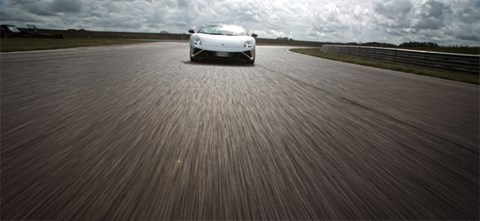
It’s been somewhat forgotten as Ferrari and McLaren have gone at it round after round, but the Gallardo’s impact on Lamborghini, and all of supercar kind, has been remarkable. We feared the results of a German-Italian tie-up might have been as disastrous as the last time these two nations collaborated closely, but the dual-nationality supercar that emerged from Audi-owned Lamborghini rewrote the rulebook, seamlessly melding Teutonic safety, security and stability with a hefty dose of Roman noise, pomp and emotion. It was a proper supercar, but sensible too, the McLaren 12C of its day – and it transformed Lamborghini. From 1963, when Ferruccio founded the upstart company that bears his name, to 2002, Lamborghini sold an average of 250 cars per year; since 2003 Lamborghini’s sold over 14,000 Gallardos, and even in 2012, the tenth year of production, 1161 rolled off the production line in Sant’Agata.
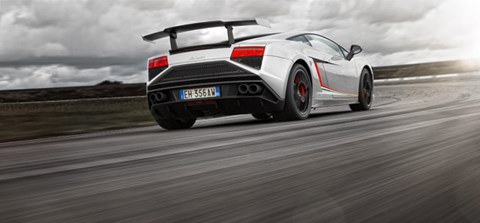
Lamborghini’s still improving the Gallardo, too. Enter the Squadra Corse, which rattles the walls of the Italian-registered transporter when 10 cylinders bark into life like an angry junkyard pitbull. It emerges out of the darkness, the Grigio Thalasso paint glinting in the morning light, the matt black rear wing menacingly enormous, and then it’s rolled onto the Tarmac, ready for us. ‘This is the greatest ever expression of the Gallardo family,’ Lambo’s R&D boss Maurizio Reggiani tells me in a pit garage at Rockingham race circuit. ‘There has been continuous development since the first Gallardo, and we have put all we’ve learnt into the new Squadra Corse. It is the sportiest and most dynamic Gallardo ever, it is the evoluzione della specie.’
Gearbox to Corsa, ESP to Off, heart to 180bpm. The Squadra Corse explodes out of the pitlane, four Pirelli Corsas finding immense traction, the monstrous V10 going feral above 7000rpm, interrupted only by a ferocious snarl as each brutal gearshift shakes the whole car. I’m scared. But at the first corner the carbon brakes bite hard, hanging you forward into your belt, and you rediscover the Gallardo’s meaty steering. It turns quickly too, with no roll, and as you pick up the throttle the front wheels drag you through the apex and onto the next straight, that incredible engine howling again. And you breathe, and remember that there’s a nice side to the Gallardo, that up to a point you can drive it hard and fast and it’s not going to send you off to join Dolly (or Saddam if you’ve been naughty). It warns you of approaching limits with understeer, always wants to pull itself straight again as soon as possible, the four-wheel-drive system meaning any clumsy right foot inputs aren’t admonished with a spin. It might appear an old-schoolsupercar, but each time we drive the Gallardo we’re reminded of its brilliance, how it can still mix it with Ferrari and McLaren.
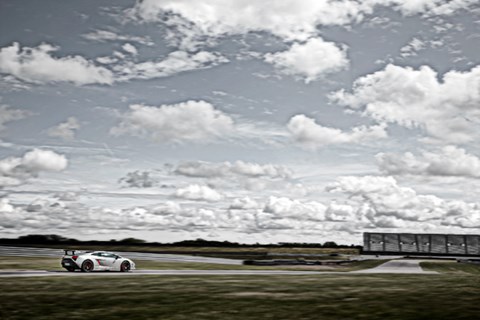
Not for long though, because although Reggiani won’t admit it, the Squadra Corse is The Final Gallardo, a last hurrah before production stops at the end of 2013 and this raging bull disappears behind the matador’s cape forever. You get the sense Lamborghini doesn’t want to let the Gallardo die, due in no small part to the fact its gestation dates back a quarter of a century. Production of the Jalpa – the Gallardo’s forgotten predecessor – ended in 1988, and despite the stability of Chrysler ownership, plans for a new baby Lambo (codenamed L140, and fitted with a V10) came to nothing as worldwide economic crisis struck. The Americans offloaded Lambo onto Indonesian firm Mega Tech in 1994 – who to their credit inaugurated a mad one-make Diablo race series – but the fate of project L140 remained the same. And Giorgetto Giugiaro’s Italdesign Calà, a 2+2 supercar concept unveiled at the 1995 Geneva motor show with a Lambo-designed 367bhp 4.0-litre V10, also led nowhere.
Lamborghini wasn’t to be deterred, and approached several makers in the hope of finally bringing its baby supercar to life. A request was made to Audi for the V8 in the A8 limo, and it piqued the interest of VW Group chairman Ferdinand Piëch. A deal was done in 1998, Lamborghini was sold to Audi, a new board of management was installed in Sant’Agata, bratwurst and sauerkraut were offered in the canteen (probably) and five years later – and fifteen after the last Jalpa – a new ‘baby’ Lamborghini arrived.
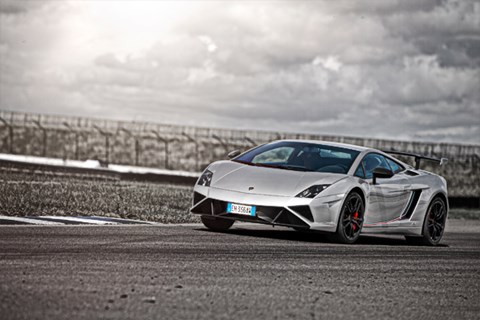
Though pity parents everywhere if all infants are born as boisterous as the Gallardo. In contrast to the Diablo-replacing Murciélago it might have felt a little tame, but otherwise the Gallardo was a fully fledged supercar, with a 493bhp 5.0-litre V10, permanent all-wheel drive, the ability to reach 62mph in a little over four seconds, and a top speed approaching 200mph. It bossed the contemporary Porsche 911 Turbo and Ferrari 360 Challenge Stradale, and two facelifts (in 2008 and 2012) have kept the Gallardo on pace with newer rivals. And now there’s this final Gallardo to savour…

‘With the Squadra Corse we wanted to not just improve upon the Gallardo, but integrate our motorsport experience too,’ explains Reggiani. ‘With the new front and rear bumpers, the rear diffuser and the rear wing from our Super Trofeo racecar, we’ve increased the aerodynamic load of the Gallardo threefold.’ Said rear wing is made from a carbon composite, as is the quick-release engine cover (also pinched from the one-make Super Trofeo race series) and along with carbon-ceramic brakes, carbon bucket seats, carbon door cards, lightweight wheels, no radio, and Alcantara and carbon trim in place of leather, the SC is 70kg lighter than a regular Gallardo. The Squadra Corse’s 5.2-litre V10 has gained an extra 10bhp too, it’s named after Lambo’s recently created racing department, and fewer than 50 will ever be made. To an empty racetrack!
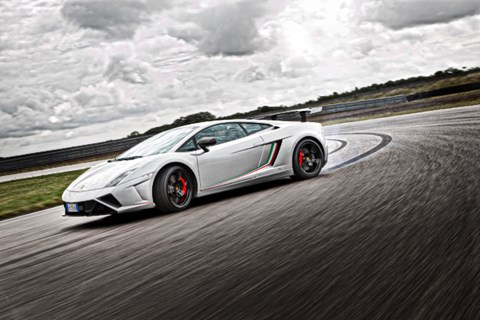
And it’s here you discover the Gallardo’s other side too. It’s stiff and initially seems at home on a circuit, but with the 4wd there’s always more understeer, and there’s nothing you can do but either back off, or throw it into a four-wheel drift – and even then it’ll snap itself straight again as soon as it gets the chance. Fine for Ben Barry, but with a helmet on top of my six-feet-five-inches, and the Gallardo’s low roofline, I’m hunched over the steering wheel like a dog trying to lick itself. Despite appearances, it’s not fun.
I’ve also a nagging suspicion there’s little difference between the Squadra Corse and the last motorsport-inspired Gallardo, 2011’s limited edition Super Trofeo Stradale, which was itself merely a Superleggera with the big wing and the racecar’s engine cover. Officially all three variants weigh 1340kg, all boast 562bhp, all hit 62mph in a eye-opening, kidney-punching 3.4 seconds, and all can produce up to three times the aero load of the standard Gallardo. Reggiani tells me lots of work has been done to create an aerodynamic balance with the new bodywork, but it feels no different from what’s come before. So let’s ignore the track – because Ferruccio never was fascinated by motorsport like old man Enzo, and besides the Diablo and Gallardo one-make series and the occasional dabble in GT3 racing, there isn’t much competition heritage – and enjoy this last-of-the-line Lambo on the road instead…

With each successive year, each new test, we expect the Gallardo to feel outdated, and although its Audi A8-sourced switchgear now belongs in a museum, there continues to be nothing wrong with the way it drives. That V10 (with two more cylinders than any ‘baby’ from arch rival Ferrari) is epic, and fires you forward with far more animosity than the same engine in the Audi R8. You’re through first gear in an instant, and although second is much longer, initially it takes all eight thousand two hundred and fifty rpm before you’ve f-i-n-a-l-l-y plucked up the courage to bury the throttle into the firewall. But the Gallardo has the grip, has the traction, and you exploit it more and more. I’m sure it’s faster than a Ferrari 458 – the ferocity and intensity are more than a match, and it’d definitely streak ahead in the wet thanks to the four-wheel drive.
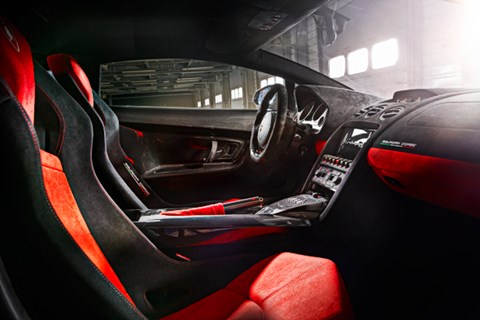
The steering is wonderful too, slower and less hyperactive than a 458’s, but with more feedback about what the front wheels are finding. And the more relaxed rack means that despite firm suspension, the nose doesn’t sniff out and follow each bump and rut as the Squadra Corse flies along. The normal Gallardo is remarkably supple, but this one has a harder edge, more so than Audi’s own version of the Superleggera, the R8 V10 Plus. Technology has moved on with the McLaren 12C’s ProActive Chassis Control too, but the Squadra Corse remains just on the right side of what is acceptable: the suspension is busy down a bumpy road, but it rarely gets bad enough to distract you from enjoying every last millimetre of throttle travel.
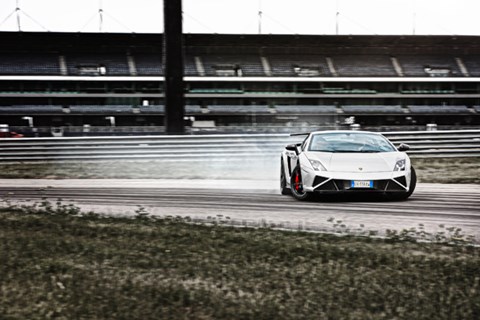
It’s the same with the gearbox. Automated manuals were once the only solution if you wanted a two-pedal transmission that could give you a thump in the back, but now a twin-clutch ’box can be smooth and refined, and engineered to smack through the gears as well. So in Auto the Squadra Corse’s E-gear is clunky, and in Corsa it sends a shockwave through the Gallardo that would probably upset the ESP if the more aggressive gearshift mode didn’t simultaneously dial back the electronic safety net. But use E-gear in halfway house Sport mode and each time you grab a bull-horn-shaped paddle you’ll never think about how many clutches you have or that you might want the shifts to be faster. It’s only the brakes that deserve any criticism: no one but Ferrari and Porsche can get the pedal feel of carbon-ceramics right, and the Squadra Corse still has a dead spot of travel that’s always afflicted the Gallardo.
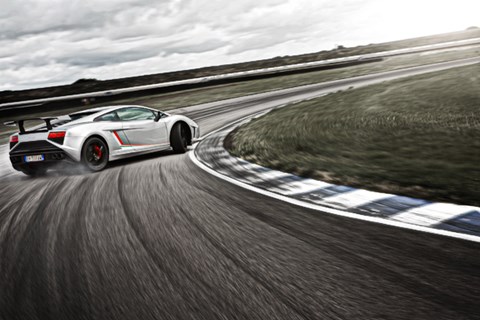
I love it though. The Gallardo’s never been perfect, never been as usable as a Porsche 911 or as delicately balance as a Ferrari 458, but there’s never been anything like it either. A decade after launch it’s still madder and badder, meaner and louder than any rival. The Miura or the Countach might have had a bigger influence on the automotive world, might have been on more bedroom walls, but it’s the Gallardo that’s the most important car in Lamborghini’s 50-year history. Better yet, it’s grown old disgracefully, and with typical Lamborghini flamboyance, signed off with an enormous rear wing strapped onto it. Goodbye Gallardo, we’ll miss locking horns with you.

Words: Ben Pulman Photography: John Wycherley